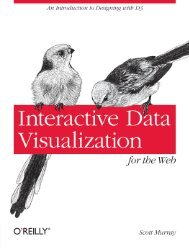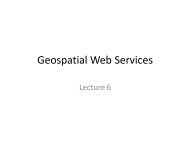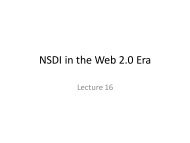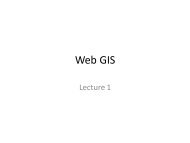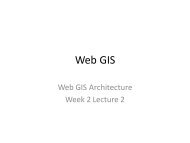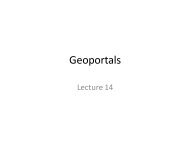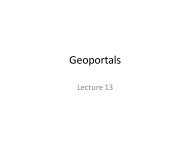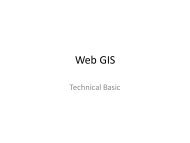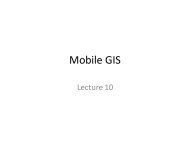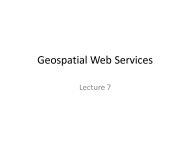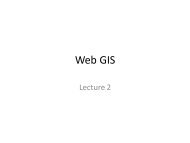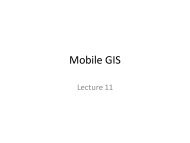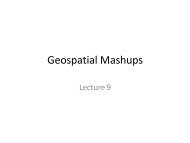geodesign-in-practice
- No tags were found...
Create successful ePaper yourself
Turn your PDF publications into a flip-book with our unique Google optimized e-Paper software.
In the case of the pronghorn antelope study, the species<br />
observations <strong>in</strong>cluded 762 telemetry fixes from 26 collared<br />
animals from May to July of 2005. The spatial extent of the<br />
analysis was def<strong>in</strong>ed by this data <strong>in</strong> comb<strong>in</strong>ation with expert<br />
knowledge of known habitat use. The spatial resolution for<br />
all environmental data was a 100-meter grid produced by<br />
resampl<strong>in</strong>g the data as appropriate.<br />
Analysts used various model<strong>in</strong>g techniques to create forage,<br />
herbaceous, sage, soil, and cumulative net primary production<br />
(NPP) layers (i.e., process models). Additional models us<strong>in</strong>g<br />
empirical field data created coyote and wolf <strong>in</strong>tensity of use<br />
and small mammal biomass layers. F<strong>in</strong>ally, available space<br />
layers were created us<strong>in</strong>g one-kilometer buffers around each<br />
pronghorn location <strong>in</strong> which po<strong>in</strong>ts were randomly generated<br />
over that space to simulate potential habitat use. S<strong>in</strong>ce the spatial<br />
scale at which pronghorn select their habitat was unknown, this<br />
process was repeated at three kilometers and five kilometers for<br />
comparative analysis.<br />
Exam<strong>in</strong><strong>in</strong>g Alternative Futures—<br />
Ecological Forecast<strong>in</strong>g<br />
EAGLES has a tool called the Swap tool that enables users to<br />
build alternative scenarios (i.e., change models) us<strong>in</strong>g an already<br />
constructed model and change only one attribute while hold<strong>in</strong>g<br />
all else constant to exam<strong>in</strong>e the effects of that change on the<br />
model. This approach allows a transparent <strong>in</strong>vestigation of<br />
the changes <strong>in</strong> levels of treatments, such as geophysical layer<br />
alterations, changes <strong>in</strong> forage availability, or more sophisticated<br />
modeled <strong>in</strong>put layer substitutions. The goal is to apply a model<br />
that previously "fit" to observed data for a potential scenario <strong>in</strong><br />
an effort to make projections about the ecological ramifications<br />
of a given landscape change (i.e., impact models).<br />
For example, a forecast about the impact of build<strong>in</strong>g a new<br />
road through a habitat would rely on the <strong>in</strong>put of a new layer<br />
that conta<strong>in</strong>s the proposed road. The user can then apply the<br />
fitted resource model to the new road layer (<strong>in</strong>stead of the<br />
orig<strong>in</strong>al layer) and view the response surface under the changed<br />
landscape. Such projections allow a measured assessment of<br />
habitat change. Visualization of the resultant surface occurs <strong>in</strong><br />
GIS, and the resultant equations and models can be exam<strong>in</strong>ed<br />
statistically, as well. The <strong>in</strong>tent is to provide a utility for plann<strong>in</strong>g<br />
for landscape change.<br />
Humans with Nature<br />
The benefit of the EAGLES toolset is that it streaml<strong>in</strong>es the<br />
f<strong>in</strong>d<strong>in</strong>g, compilation, and <strong>in</strong>tegration of data by allow<strong>in</strong>g the user<br />
to identify the geospatial data <strong>in</strong>puts, region of <strong>in</strong>terest, scale,<br />
and a common data resolution—even a temporal resolution—<br />
to make it easier to assemble available national datasets <strong>in</strong>to<br />
a common georeferenced coord<strong>in</strong>ate system us<strong>in</strong>g ArcGIS.<br />
Apply<strong>in</strong>g such a workflow to standardized datasets across the<br />
United States would help propel the adoption of GeoDesign.<br />
Geodesign <strong>in</strong> Practice: Design<strong>in</strong>g a Better World<br />
J10221<br />
Where the Wild Th<strong>in</strong>gs Are <strong>in</strong> Yellowstone Park<br />
24




